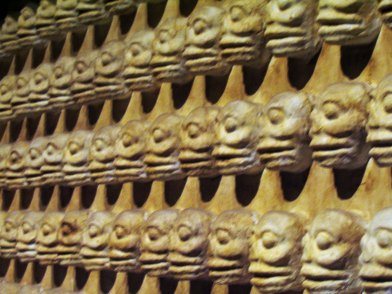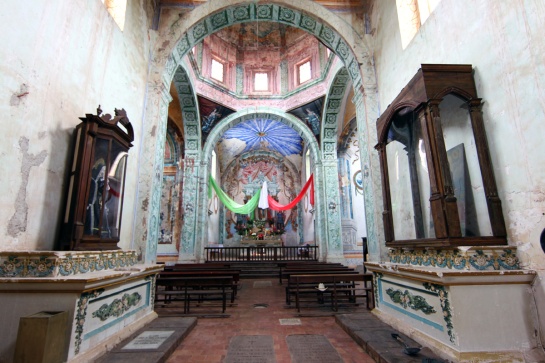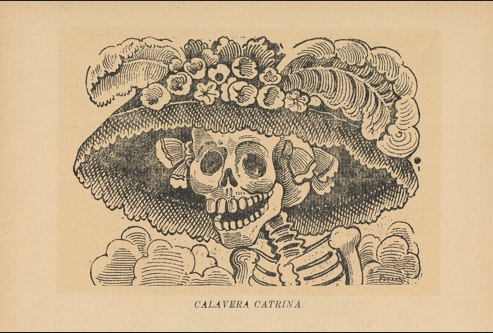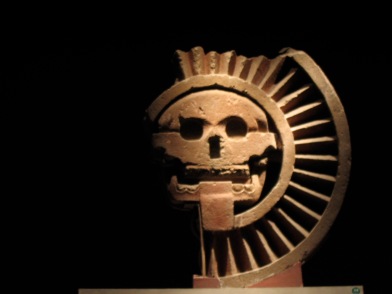 For generations the Day of the Dead has been a unique and sacred festivity for people of Mexican descent on both sides of the U.S.-Mexican border. El día de los Muertos, an ancient Mexican celebration in which families reconnect with departed ancestors, provides a special opportunity to remember and celebrate the life and legacy of those who have moved ahead into the sacred lands of Mictlan, the realm of the “fleshless.”
For generations the Day of the Dead has been a unique and sacred festivity for people of Mexican descent on both sides of the U.S.-Mexican border. El día de los Muertos, an ancient Mexican celebration in which families reconnect with departed ancestors, provides a special opportunity to remember and celebrate the life and legacy of those who have moved ahead into the sacred lands of Mictlan, the realm of the “fleshless.”
ANCIENT MEXICO
The veneration of ancestors in ritualized practices is as ancient in Mesoamerica and other areas in the Western hemisphere as the domestication of corn and the development of agriculture. 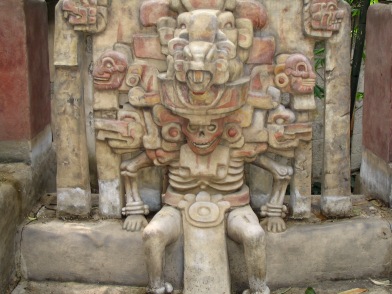
In Mesoamerican calendars (with 18 months of 20 days each) two complete months were dedicated to the departed ancestors (approximately the last week of July and the month of August in the Gregorian calendar). The Aztecs in Central Mexico named these months Miccailhuitontli and Hueymiccahuitl, and for forty days they venerated ancestors and the Mictlantecuhtli, the Lord of Mictlán.
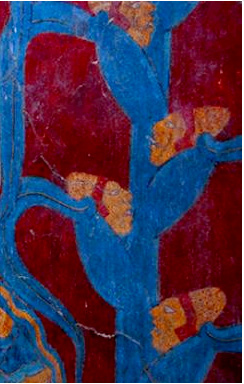 Mictlán (in Nahuatl) is often translated as “the underworld” or “the land of the dead”. While some European religious writers erroneously translated it as “Hell,” Mictlán was considered the “Great Cave” or the “Great Womb” where living animals, humans, plants and cultures were originated and destined to rest. The bones of ancestors were normally buried in the cornfield or in the center of the residence, right under the foyer. Their bones were considered essential to reactivate the life cycle in the land, especially the harvest of corn. As people were considered to be created and made of corn, they were also considered corn seed to feed the land. The veneration to the ancestor, thus, coincided with the harvest of corn across the Mesoamerican landscape. The traditional ways were altered by the changing power structures that came with the Spanish Conquest and the Christianization of the region. The honoring of ancestors was moved from the two month celebration in July and August to coincide with Catholic All Saints Day and All Soul’s Day on November 1 and 2nd respectively. The celebration became Dia de los Muertos.
Mictlán (in Nahuatl) is often translated as “the underworld” or “the land of the dead”. While some European religious writers erroneously translated it as “Hell,” Mictlán was considered the “Great Cave” or the “Great Womb” where living animals, humans, plants and cultures were originated and destined to rest. The bones of ancestors were normally buried in the cornfield or in the center of the residence, right under the foyer. Their bones were considered essential to reactivate the life cycle in the land, especially the harvest of corn. As people were considered to be created and made of corn, they were also considered corn seed to feed the land. The veneration to the ancestor, thus, coincided with the harvest of corn across the Mesoamerican landscape. The traditional ways were altered by the changing power structures that came with the Spanish Conquest and the Christianization of the region. The honoring of ancestors was moved from the two month celebration in July and August to coincide with Catholic All Saints Day and All Soul’s Day on November 1 and 2nd respectively. The celebration became Dia de los Muertos.
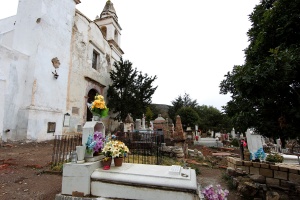 With the colonial influences, the departed were no longer buried in the home or the cornfield but in churchyard burial grounds. If a family had money or influence, their departed could be buried under the foyer of the church. Mexicans began to honor their dead in a syncretic way, combining Catholic and indigenous traditions. Day of the Dead ofrendas were set up in the home and by the tombs of the departed.
With the colonial influences, the departed were no longer buried in the home or the cornfield but in churchyard burial grounds. If a family had money or influence, their departed could be buried under the foyer of the church. Mexicans began to honor their dead in a syncretic way, combining Catholic and indigenous traditions. Day of the Dead ofrendas were set up in the home and by the tombs of the departed.CONTEMPORARY MEXICO
La Catrina goes to murals, galleries and universities
In 1948 Diego Rivera featured “La Catrina” as the central figure in his mural “Sueño de una tarde dominical en la Alameda” in the Del Prado Hotel in Mexico City. A year before Frances Toor had published in New York “A Treasury of Mexican Folkways” with illustrations by Carlos Mérida, including the ethnographic descriptions of Day of the Dead celebrations in urban and rural Mexico.  Toor described it as “a national holiday” and related her observations in the Dolores Cemetery, Mitla, Oxchuc and Chan Kom, in Mexico City, Oaxaca, Chiapas and Yucatan, respectively. She finished with a report on the festivity in Janitzio, a Tarascan island in Michoacan. Toor described it as “the most exotic and beautiful of the ceremonies”. In the 1950s the Day of the Dead became a central feature for scholars and artists in Mexico searching for the sources of Mexican cultural identities in juxtaposition with the increasing modernization trends of Mexican economy and social life. Octavio Paz published in 1950 “El Laberinto de la Soledad”, a collection of essays on Mexican culture in which the connections between Mexicans and Dead were prominently featured.
Toor described it as “a national holiday” and related her observations in the Dolores Cemetery, Mitla, Oxchuc and Chan Kom, in Mexico City, Oaxaca, Chiapas and Yucatan, respectively. She finished with a report on the festivity in Janitzio, a Tarascan island in Michoacan. Toor described it as “the most exotic and beautiful of the ceremonies”. In the 1950s the Day of the Dead became a central feature for scholars and artists in Mexico searching for the sources of Mexican cultural identities in juxtaposition with the increasing modernization trends of Mexican economy and social life. Octavio Paz published in 1950 “El Laberinto de la Soledad”, a collection of essays on Mexican culture in which the connections between Mexicans and Dead were prominently featured.
DOLORES OLMEDO
A pivotal development in the expansion of the celebration into museums, galleries and public spaces occurred in connection with Dolores Olmedo and Diego Rivera’s last days. Dolores Olmedo, a multitalented artist, business woman and art collector, had modeled for Rivera in the 1920s. In 1954 Olmedo and Rivera reignited their friendship and travelled with a group to Day of the Dead celebration in Janitzio. Olmedo collected artwork from Diego Rivera, Frida Kahlo and other artists, while amassing an impressive collection of Mesoamerican art likewise. One year after Frida Kahlo’s dead in 1954, Diego Rivera set up a trust to create a museum in their two residences, the Casa Azul and the Anahuacalli. Rivera donated his artwork to the Mexican people under the guardianship of Olmedo. Rivera travelled in 1955 to the Soviet Union, looking for effective cancer treatment, and returned to Mexico in 1956 to reside in Acapulco. As Rivera’s fight against cancer waned, Olmedo decided to create a Day of the Dead altar dedicated to him, giving birth to the first public ofrenda in the history of the celebration. In 1957 Rivera returned to Mexico City and died. Dolores Olmedo decided to build artistic ofrendas every year in the Anahuacalli museum, dedicated to the memory of Diego Rivera. In partnership with the Banco de Mexico, Dolores Olmedo supervised and financed the completion of the Anahuacalli museum, which opened to the public in 1964. (The Casa Azul had become a museum in 1958.) Dolores Olmedo altars from 1956 on are therefore the first public ofrendas in Mexico that explored new ways to incorporate the traditional celebration into the world of contemporary art.
VISUAL ARTS
Photographers, painters, filmmakers and artists explored the Day of the Dead celebrations in Mexico extensively in the second half of the Twentieth century. Mexican photographers presented the feast in different ways, from journalistic photo-essays to more conceptual interpretations. Nacho López visited Janitzio in 1950 to create “Noche de Muertos”, documenting the festivity in the island’s cemetery in Michoacán. Julio Mayo in 1954 and 1957, Faustino Mayo in 1955, the Casasolas in 1956, continued with this practice. 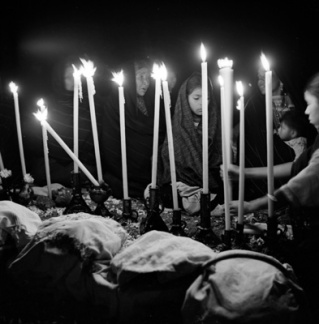
MEXICAN CINEMA
Soviet filmmaker Sergei Eisenstein traveled to Mexico in 1930, financed by Upton Sinclair and the “Mexican Trust Film” to make a movie about Mexicos history and people. The epilogue in the plan was dedicated to the Día de los muertos. Eisenstein and the company entered a dispute that ended the project after shooting over 30 hours of film. Without Eisenstein the company edited and released segments of the master project, “Death Day”, which was released in 1934 as a short film. Grigory Alexandrov, Eisenstein’s assistant, edited the entire film, released in 1979 as “Que Viva México”, Eisenstein’s original title. Following the steps of “Que viva Mexico” Mexican cinema used the Day of the Dead frequently as a resource to provide “authenticity” and flavor to the depiction of working classes and indigenous groups in popular films. The immensely popular trilogy “Nosotros los pobres” (1948), “Ustedes los ricos” (1948) and “Pepe el Toro”(1953) starts and ends with the main protagonists visiting the cemetery on November 2 in Mexico City.
CHICANO DAY OF THE DEAD
In the United States, Mexican communities have turned El día de los Muertos into a public celebration of Latin@/o cultures, a ritual of rebellion & hope and an opportunity to raise awareness of cultural and historical collective memory. In the midst of the Chicano civil rights movement demands for political representation, access to education, labor rights for farmworkers, gender equality and anti-Vietnam War, Mexican communities in the United States also experienced a cultural revival vindicating Mexican popular traditions and celebrating the resilience of indigenous culture. The revival of Mexican culture provided new opportunities to adapt, change and transform the traditions themselves. Chicano artists, activists and intellectuals embraced the Day of the Dead with new perspectives and transformed the event into rituals of cultural affirmation, community development and artistic expression. In San Francisco and East Los Angeles two community organizations were at the forefront of this new wave: La Galería de La Raza and Self Help Graphics. In 1972 both groups separately organized the Día de los Muertos celebration with processions, artwork, educational and community activities. Through public rituals that merge artistic expression with community celebration, the Day of the Dead in California and other Chicano communities evolved into a celebration of the Mexican experience in the United States. At the core of this metamorphosis was the contribution of visual artists centering their work and performances on the history and culture of Mexicans in the United States. Dia de Muertos became a vehicle for social change through the programming of multiple educational, cultural and artistic activities in the communities. Following on Olmedo and other artists work, California Chicanos turned ofrendas into conceptual artifacts that reflected on the multiple layers of the Chicano experiences. Day of the Dead Altars evolved from domestic family mementos into individual and collective artistic expressions. Visual artists like Ralph Maradiaga, Patsy Valdes, René Yáñez, Amalia Mesa-Bains, Ester Hernández, Gronk and many other led this new wave turning the Day of the Dead into a medium for artistic expression, where conceptual ofrendas or artistic altars were no longer attached to family ties but embedded into contemporary trends in the arts and centered on the chicana/o experiences as a collective entity. In 1978 the Galería de la Raza organized a path-breaking celebration, dedicating the event to Frida Kahlo, focusing on the legacy of the Mexican painter. The following decade museums, galleries and universities echoed this new trend in which the Día de los Muertos would adopt a multilayered dimension with artistic, political and cultural features. Institutions in cities like Chicago, Detroit, San Antonio and New York began scheduling artistic events and allocating exhibition spaces to the Day of the Dead. The Detroit Institute of Arts, for instance, organized such an event in 1986, commemorating the 50th anniversary of the Detroit Industry Murals by Diego Rivera. Excerpts from Juan Javier Pescador’s forthcoming book on the history of the Day of the Dead

